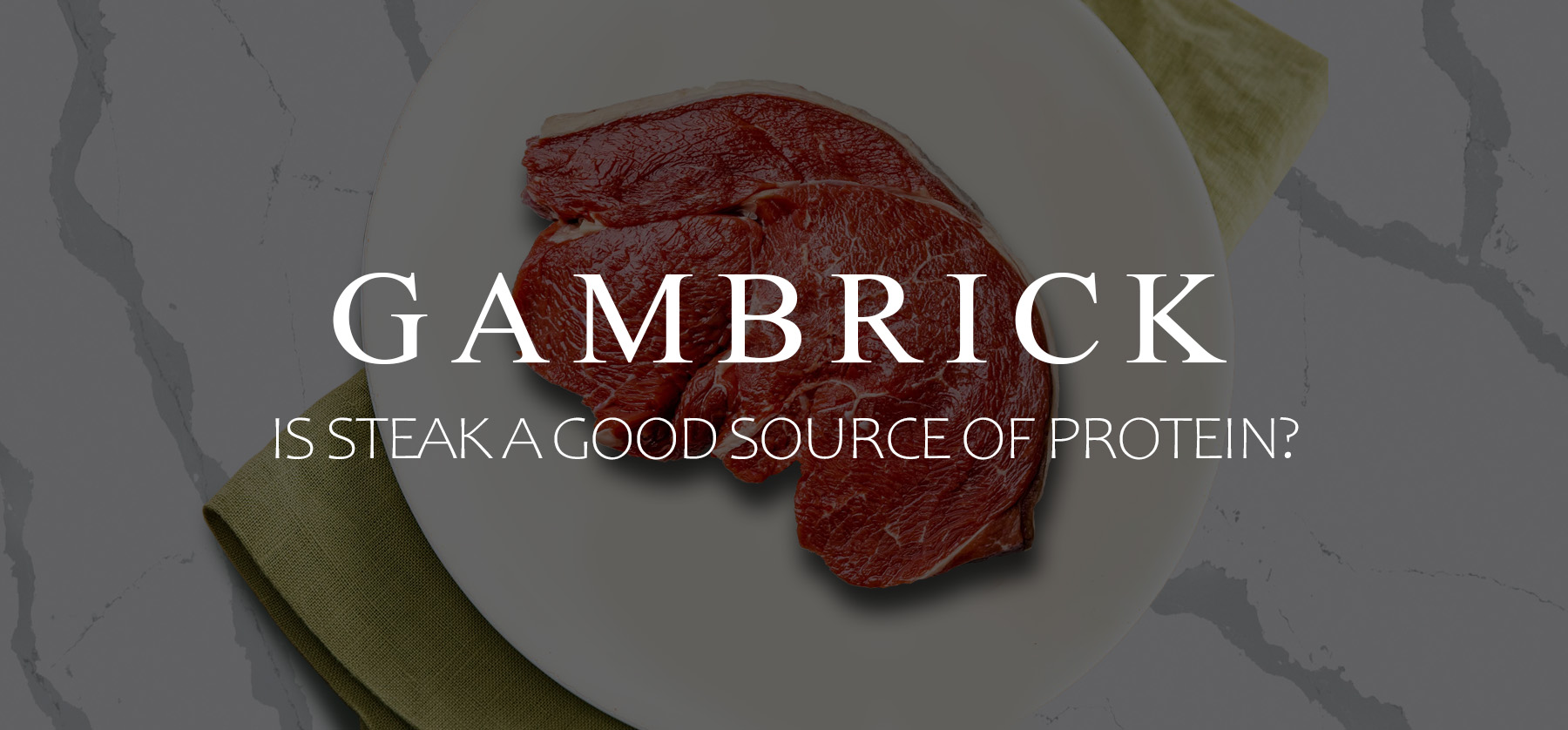Is Steak A Good Source Of Protein?
Steak is a very good source of protein. A typical 4 ounce sirloin steak provides about 33 grams of protein. Animal-based foods like beef, pork, poultry, fish, eggs, and dairy products are high in complete proteins. While plant-based foods like fruits, vegetables, grains, nuts, and seeds typically lack one or more essential amino acids. Protein is found throughout the body in muscles, bone, skin, hair, organs and even our blood. It’s made from over twenty amino acids which are considered the building blocks of life. Nine of those amino acids: histidine, isoleucine, leucine, lysine, methionine, phenylalanine, threonine, tryptophan, and valine, are known as essential amino acids and must come from food. Steak is a good source of all nine essential amino acids plus the acids which are considered non-essential.
Protein is an essential macronutrient which is used to repair tissue, build lean muscle mass and act as an energy source when carbohydrates and fat are not available. This is called Ketosis. The National Academy of Medicine recommends that adults get a minimum of 0.8 grams of protein for every kilogram of body weight per day. That’s just over 3.5 grams for every 10 pounds of body weight. For a 200 pound person that’s about 70 grams of protein or an 8.5 ounce steak.
Even though steak is a great source of complete protein, it can also be high in fat and calories. So be careful about what cuts you choose and how you cook it.
Is Steak A Healthy Protein?
Yes, steak is one of the best protein sources you can eat which provides a complete protein with all the essential amino acids your body needs. Protein is important to build and repair pretty much every cell in your body. It’s an essential macronutrient which is used to keep our hair, nails, skin, bones, cartilage, muscle, organs and blood in good health.
All types of steak, like Skirt, Sirloin, Porterhouse, T-bone or Tenderloin, provide about 7 grams of protein per ounce.
A serving size of steak is considered 3 ounces. This is about the size of a deck of cards at around 1 1/2 inches thick.
One 3 oz serving of cooked steak provides about 25 grams of protein including all the essential amino acids plus iron and zinc.
Even though steak is a fantastic source of complete protein, it can also be high in fats.
- Be selective when buying steak.
- Look for cuts that are lean and easy to trim.
- Cut large strips of fat off the meat before you cook it.
- Marbled steak is a good choice because the fat melts away when you cook it.
- One serving of 3 ounce steak has about 25 grams of complete protein.
- A serving of steak fits in an average size palm.
How you cook steak matters too. Grilling is a great choice because fat melts off the meat and doesn’t end up on your plate. Don’t add additional fats to your steak unless it’s really lean because it has it’s own.
Steak is a great source of healthy protein. But it can also have lots of unhealthy fats. Be selective about which cuts you buy and how you cook them.
How Much Protein Is In Steak
As a general rule of thumb, raw steak has about 21 grams of protein per 3 ounce serving. This includes 16 g of total fat, 7 g saturated fat, 66 mg cholesterol and 230 calories. However, the cut of beef you choose and how you prepare it effects how much protein and other nutrients are in the meat.
Below is a chart showing the most popular cuts of steak along with how much protein, fat, cholesterol and calories they contain.
| CUT | SERVING SIZE |
PROTEIN | FAT | SATURATED FAT |
CHOLESTEROL | CALORIES |
| Skirt | 3 oz |
22 g | 10 g | 4 g | 51 mg | 187 |
| Flank | 3 oz | 18 g | 4 g | 1.8 g | 51 mg | 116 |
| Porterhouse | 3 oz | 15 g | 12.9 g | 5.1 g | 48 mg | 186 |
| T-Bone | 3 oz | 15 g | 12.9 g | 5.1 g | 48 mg | 186 |
| Sirloin | 3 oz | 18 g | 10.8 g | 4.5 g | 63 mg | 171 |
| Ribeye | 3 oz | 20 g | 18 g | 8 g | 68 mg | 248 |
| Tenderloin | 3 oz | 18 g | 15 g | 6.3 g | 72 mg | 210 |
| Chuck | 3 oz | 16 g | 14 g | 6 g | 58 mg | 189 |
| NY Strip | 3 oz | 19 g | 2 g | 0.9 g | 47 mg | 99 |
| Round | 3 oz | 18 g | 6.9 g | 2.7 g | 60 mg | 144 |
| Flat Iron | 3 oz | 17 g | 5 g | 2 g | 60 mg | 116 |
Keep in mind this chart shows the average nutritional facts for various cuts of raw steak. prepared steak has different nutrition that when it’s raw. In some cases drastically different. How you cut and cook the meat effects it’s nutrition.
For a healthier steak do the following:
- Cut off excess fat.
- Grill the meat instead of pan frying to drain away fat.
- Don’t add additional fat to the meat.
Daily Protein Requirements
The National Academy of Medicine states that an acceptable protein intake should be anywhere from 10% to 35% of calories each day. The average person consumes about 2000 calories per day so that’s about 200 to 700 calories worth of protein.
- Steak is about 77 calories per ounce. A 3 ounce single serving of steak provides about 230 calories and 25 grams of essential protein. That’s a very healthy meal if you cut out all the fats.
- All protein is about 4 calories per gram.
- Fat is about 9 calories per gram.
- Steak is a fantastic source of complete essential proteins and is low in calories. However, the fat it contains is very high in calories. When buying and preparing steak, look for lean cuts and don’t add too much additional fat to the pan.
- Protein requirements will vary based on lifestyle. A vigorous workout regimen requires more protein per day to repair and build damaged muscles. But if you live a relatively sedentary life, your daily calorie and protein requirements will be less.
A persons daily protein intake should scale based on their activity level. Athletes for example, can require more than twice the amount of calories and protein as the average person. They burn more calories when they exercise and need more protein to repair and build damaged tissue.
Steak Can Be High In Fat & Cholesterol
Steak is a great source of complete protein which contains all the essential amino acids. However is also can contain saturated fats and cholesterol. Eating too much saturated fat can raise low-density lipoprotein, which is the bad cholesterol in your blood.
Over time, elevated low-density lipoprotein levels can harden arteries, raise blood pressure and boosts your risk of cardiovascular disease.This is why saturated fat intake should be less than 10% of your dietn according to the Mayo Clinic.
When you make steak a part of your diet, be choosy about which cuts you eat and how you cook it.
- Look for leaner cuts of beef with less fat.
- Trim excess fat before you cook the meat.
- Grilling steak is generally considered healthier because fats can drain away.
- Don’t add extra fat to the steak unless it’s really lean like skirt or flank.
An average 2000 calories per day diet should contain no more than 200 calories of saturated fat. Because fats are about 9 calories per gram, you can only have about 22 grams of saturated fat per day.
You should also be aware of the dietary cholesterol you consume on a daily basis. One single serving 3-ounce sirloin steak contains about 3.5 grams of saturated fat and 75 milligrams of cholesterol. But you can reduce those numbers by cutting away excess fat before you cook and grilling the beef instead of pan frying.
Since steak can be high in saturated fat and cholesterol, opt for leaner cuts and grilling instead of pan frying in fats or butter.
Is There A Lot Of Protein In Steak?
Yes, a single 3 oz serving of steak contains about 21 grams of complete protein. A complete protein contains all the essential amino acids. In addition to proteins, steak also contains vital nutrients like iron and zinc. An 8 oz steak, which is a common size cut, contains about 56 grams of protein. Between 10% to 35% of your calories per day should come from protein. So if you eat 2,000 calories, that’s 200–700 calories from protein, or 50–175 grams.
A single 8 oz steak contains enough protein for the average person eating about 2000 calories per day.
Summary: Is Steak A Good Source Of Protein?
Steak is a very good source of protein. A typical 4 ounce sirloin steak provides about 33 grams of protein. Animal-based foods like beef, pork, poultry, fish, eggs, and dairy products are high in complete proteins. While plant-based foods like fruits, vegetables, grains, nuts, and seeds typically lack one or more essential amino acids. Protein is found throughout the body in muscles, bone, skin, hair, organs and even our blood. It’s made from over twenty amino acids which are considered the building blocks of life. Nine of those amino acids: histidine, isoleucine, leucine, lysine, methionine, phenylalanine, threonine, tryptophan, and valine, are known as essential amino acids and must come from food. Steak is a good source of all nine essential amino acids plus the acids which are considered non-essential.
Protein is an essential macronutrient which is used to repair tissue, build lean muscle mass and act as an energy source when carbohydrates and fat are not available. This is called Ketosis. The National Academy of Medicine recommends that adults get a minimum of 0.8 grams of protein for every kilogram of body weight per day. That’s just over 3.5 grams for every 10 pounds of body weight. For a 200 pound person that’s about 70 grams of protein or an 8.5 ounce steak.
Even though steak is a great source of complete protein, it can also be high in fat and calories. So be careful about what cuts you choose and how you cook it.
If you have any questions about steak, email any time.





















